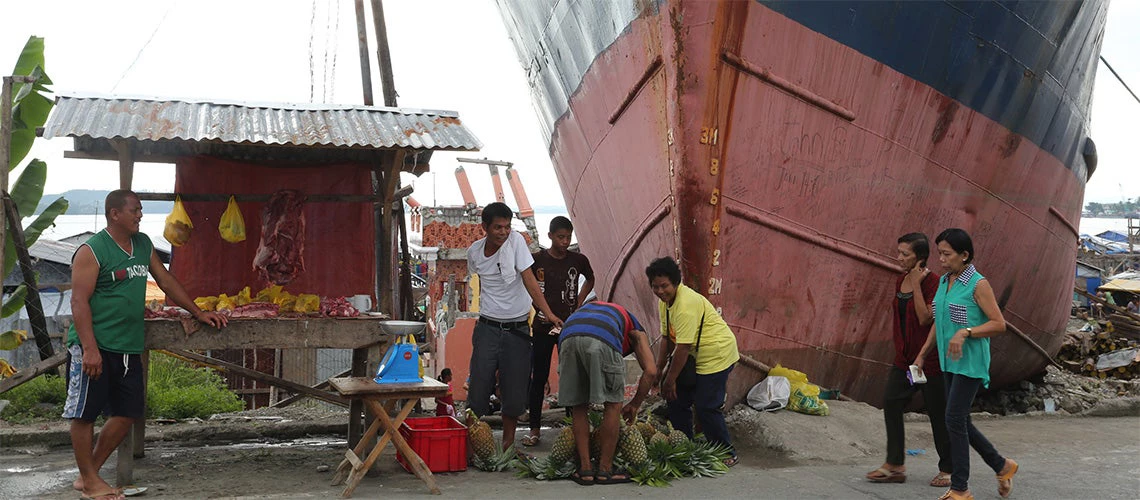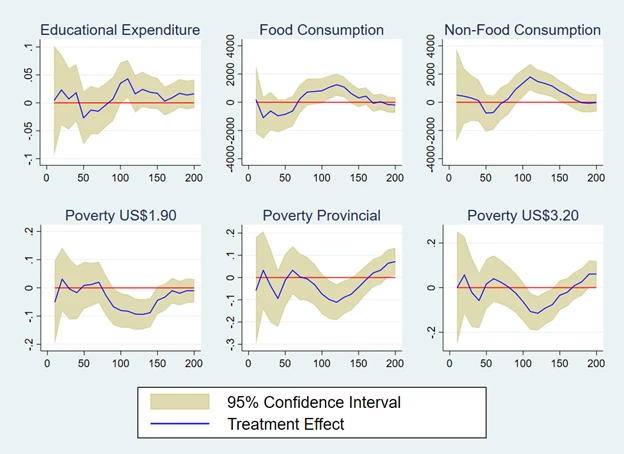 Residents affected by typhoon Haiyan (Yolanda) carry on with their daily activities | © Dominic Chavez/World Bank
Residents affected by typhoon Haiyan (Yolanda) carry on with their daily activities | © Dominic Chavez/World Bank
Helping beneficiary households better cope with adverse life events is one of the main assurances of social protection programs. By providing a basic income, cash transfer programs are designed to keep a household from falling further into poverty. Such poverty traps can occur, if for example, a household is forced to sell their assets or assume debt in order to meet immediate financial needs. The poverty trap can also have detrimental generational impacts if the household is forced to drastically reduce food consumption or take their children out of school to cut costs or add income earners. In the aftermath of the disruptions induced by the Covid-19 pandemic, the performance of social protection policies in the context of an aggregate shock is of interest. Yet, existing research on this topic is surprisingly scarce.
To shed more light on the topic, I looked at the effects of the Philippines’ Pantawid Pamilyang Pilipino Program (4P) cash-transfer program in the aftermath of typhoon Yolanda. This program paid households ₱500 (around US$ 10.40) per month as a health benefit, plus ₱300 monthly for ten months each year for each of up to three children attending school. To receive these benefits, households had to comply with health and educational conditionalities (for example, children must attend 85 percent of classes every month). The data came from the 2012 and 2015 rounds, consisting of independently drawn cross-sections, of the Family Income and Expenditure Survey (FIES). This data provides an aggregate shock that allows for the identification of affected vs. non/less-affected households; the availability of data shortly before and not too long after the event, and the ability to identify beneficiaries and non-beneficiaries in the data. With this approach, I was able to use triple-differences to identify causal effects of the program: i) before and after, ii) beneficiary vs. non-beneficiary, iii) exposure vs. non-exposure to the typhoon. While the definition of the first two differences is straightforward, there is no clear boundary for being exposed to the typhoon. I defined exposure as living within a given distance to the storm path. The control group was then defined as households living within a band of the same distance on either side of the treatment group. That is, if the treatment group was defined as living within 100km to the storm path, the control group consisted of households with a band at 100-200km distance.
The FIES looks at the effect on six outcomes of interest: First, a binary indicator for households reporting any educational expenditure. This variable was created as a proxy for school attendance and has only been defined for households with school-aged children (The FIES does not capture attendance directly). Next, the FIES looks at the two continuous outcomes of per-capita expenditures on food and non-food items and services. Finally, I looked at the binary outcomes of falling below three different poverty lines. These correspond to extreme poverty (at US$ 1.90 at the time of conducting the study), poverty for lower middle-income countries (US$ 3.20), and the corresponding provincial poverty line as defined by the Philippine government. The latter lies between the former two.
Figure 1 shows the main results from the study. Since there is no objective distance that separates affected from unaffected households, I started by defining the distance from the storm path at 10km and then moved in 10km increments to 200km. At too close a distance, households in the treatment and the control group will be almost equally affected and no differential effect is detectable. At too far a distance, unaffected households will be assigned to the treatment group, drawing the estimate towards zero. As the sample size increases with the distance to the storm path, the narrower the confidence intervals become. The results show that the 4P program had a statistically significant and detectable effect with a treatment group defined at distances roughly between 100-150km. The effect on educational expenditures is the weakest, possibly indicating its limitations as a proxy for school attendance. The effects on non-food consumption are much more pronounced than those on food consumption. To put this into perspective, the average household in the sample spends ₱9,392 on per-capita non-food consumption. At a treatment distance of up to 110km, the maximum effect, it was estimated that an affected household spent ₱1,691 more on non-food consumption if it was a 4Ps beneficiary. This result is also reflected in the program’s effect on poverty rates. Extreme poverty is estimated to have been reduced by up to 8.5 percentage points (with a sample average of 14 percent) for affected program beneficiaries. The effects are smaller in magnitude at the two higher poverty lines.
Figure 1: Estimated effects for different cutoffs in the distance to the typhoon path

These results show that the 4Ps program has been successful in protecting households against falling into destitution after typhoon Yolanda. Consumption and poverty are of course intrinsically linked, with the latter being an indicator of the former falling below a pre-established threshold. A second result is the larger effect on non-food consumption relative to food consumption. This seems plausible, given that households facing negative shocks will reduce non-food consumption much more compared to food consumption. That is, the demand for food can safely be assumed to be much more inelastic than for other goods. These findings show that cash-transfer programs can provide effective protection in contexts of aggregate shocks.


Join the Conversation